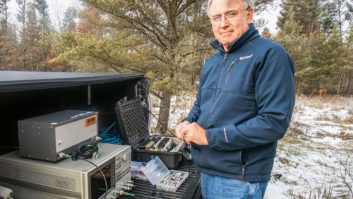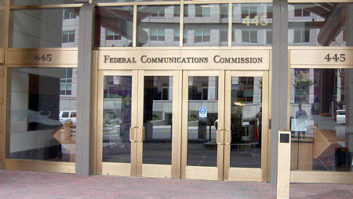WASHINGTON Sources familiar with public warning issues expect the FCC’s overhaul of the Emergency Alert System to be completed in 2005. However, pinpointing exactly when the FCC will release the report and order is difficult, and much will depend on the new chairman’s approach.
The commission’s review of proposed changes to EAS rules released last August continues. It is based in part on the recommendations of the Media Security and Reliability Council, an FCC advisory committee and the now-defunct Partnership for Public Warning.
A single federal entity should have oversight of EAS in this country, MSRC and PPW recommended.
The FCC also is trying to determine whether broadcaster participation in non-national alerts should be mandated.
Jim Daily, former director of the Office of Homeland Security within the FCC’s Enforcement Bureau, said the timing of the release of the EAS Report and Order is unclear.
“We continue to hold … meetings with public warning vendors and other proponents of public warning in this country. Internal deliberations should begin soon,” he said.
Daily announced his resignation of that post subsequent to speaking to RW. His retirement was to become effective by the end of April; Ken Moran was named interim director of the commission’s Office of Homeland Security.
Several emergency warning sources said they expect the commission to integrate existing EAS into a larger, open standards-based, “all-media” national warning system without a lot of changes to current EAS rules and equipment requirements.
Daily characterized the volume of comments to the EAS NPRM as “heavy,” with more than 150 comments and reply comments filed last fall.
“We continue to work closely with the U.S. Department of Homeland Security and FEMA on issues and programming,” he said.
Daily said the Federal Emergency Management Agency, which is part of the Department of Homeland Security, has been given the “executive-level position and the role of program manager” on leading public warning in the country.
Daily anticipated that drafting of the document would begin by the time a new chairman was in place. Commissioner Kevin Martin was elevated to the position of chairman by President Bush in March; Enforcement Bureau Chief David Solomon intends to depart in May.
The FCC’s Enforcement Bureau regulates EAS participation by requiring stations to have working EAS encoder/decoders and to conduct regular system tests.
Of a perceived shift in EAS oversight, Reynold Hoover, director of FEMA’s National Security Coordination Office, said, “We have re-engaged with the FCC and NOAA to find solutions that work in this post-9/11 world. The FCC continues in its role with enforcement while (FEMA) focuses more on the executive side with an emphasis on execution of the program. We have a good relationship and work very closely with the FCC.”
Hoover said the Department of Homeland Security is in the process of overhauling the Primary Entry Point network. FEMA maintains dedicated phone lines from the White House to 34 PEP stations that reach approximately 90 percent of the continental United States, plus Hawaii, Alaska and Puerto Rico. The PEP system allows the president to issue an Emergency Alert Notification and address the American public during an emergency.
“We will add additional stations to the PEP network so that every state will have a PEP station. We could have close to 60 when it’s done,” Hoover said.
In addition to more radio stations and a broader coverage area, FEMA is expecting to add satellite distribution of emergency messages from DHS to PEP stations.
“We are exploring today’s technologies to expand the system. We are asking the Primary Entry Point Advisory Committee to give us their recommendations with hope that we’ll have everything in place by 2006,” Hoover said.
DHS is developing two satellite systems, one a simple digital audio distribution network without Internet or POTS dependence, said Mark Manuelian, president of the PEP Advisory Committee.
“The second system is a secure data distribution system that would meet federal encryption and reliability standards. The data stream would be based on Common Alert Protocol,” Manuelian said.
The PEP program is federally funded and controlled. Funding is in place to expand the PEP network, Hoover said, with $2 million earmarked from this year’s federal budget and another $10 million from Information Analysis and Infrastructure Protection, another part of DHS.
Outdated?
Some EAS detractors have argued that the PEP network is outdated because not every LP1 station can receive a signal from a PEP station.
“We have been disappointed with the PEP plan in Connecticut, because we do not have a PEP station in our state, and coverage from New York and Boston PEP stations barely reached our primary stations,” said Mike Rice, president of the Connecticut Broadcasters Association.
Rice believes if FEMA is going to build up the PEP network, it must also follow up with system testing.
“PEP itself has never been tested to see if the system works. Even if it were just once a year in the middle of the night, they ought to test it,” Rice said.
Manuelian said, “Under ordinary conditions, some state EAS plans have not had reasonable access to a PEP signal. In other states, little or no effort was made to include PEP in the state EAS plans. It’s hoped that by giving each state a PEP station, all states will include PEP in their plans.”
Each PEP station is equipped with a shelter, a small studio, electromagnetic pulse protection, special EAS encoders and 30 days of fuel to run generators, Manuelian said.
Manuelian said FEMA is responsible for ordering a PEP system test and has never deliberately tested the system. “However, we have tested each box at each site to make sure they work,” he said.











